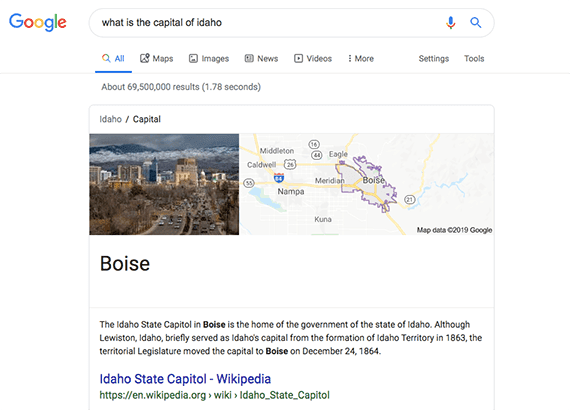New technologies and changing consumer behaviors are impacting ecommerce marketing at its core.
Some of the changes affect established tactics, such as search engine optimization. Others, such as developing and managing chatbots, are new. All require ecommerce marketers to master important new skills.
SERP Position Zero
SEO is arguably the most important ecommerce marketing fundamental. Done well, SEO can have a powerful impact on an ecommerce business long-term. But SEO is changing.
Last year, Rand Fishkin, the founder of Moz and SparkToro, reported that 61.4 percent of tested Google mobile queries in September 2018 did not result in a click.
In many of these cases, Google simply answered the question posed in the query directly on the results page, no click required.
For example, if you searched “what is the capital of Idaho,” you would have the answer without having to click further. You get a picture, a map, and the word “Boise” along with some of the content from the “Idaho State Capitol” Wikipedia post. If you did click, you would probably be on the recommended resource, which is now in position zero.

Google users have likely seen a SERP that answers a question, such as “what is the capital of Idaho.”
This sort of a position-zero answer can impact ecommerce and content marketing. As an example, if you searched on Google for “how to pick a gift for my grandkids,” you get a featured snippet, suggesting that you “talk with mom and dad first” and “make sure the gift is age appropriate.”
Thus it is not enough to win SERP position one in 2020. You also need to earn featured snippets. And that requires a new optimization process.

A query such as “how to pick a gift” could be important for ecommerce companies. But on this SERP, success is winning the featured snippet.
Semantic SEO
For 2020 and beyond, optimizing for position zero isn’t the only new SEO-related fundamental. You’ll also need to optimize for semantic phrases, not just traditional keywords or keyword phrases.
With the rise of artificial intelligence and voice search, Google, Bing, Yahoo, and Amazon are expected to move further away from lexical results toward semantic.
Lexical results are where the search engine tries to match the query, word for word. Semantic results, however, attempt to understand the query’s meaning and provide the best answer regardless of the exact words used.
“In 2010, optimizing for search engines meant snapping up as many backlinks as possible and including more keywords than side dishes at a Thanksgiving dinner,” wrote Aleh Barysevich in a 2018 Search Engine Journal article.
“Back then, SEO meant understanding how search engines generated results so that we could reverse-engineer content that ranks higher,” Barysevich continued. “Today, search engine understanding has evolved, and we’ve changed how we optimize for it as a result.
“Identifying keywords is no longer enough. Now, you need to understand what those keywords mean, provide rich information that contextualizes those keywords, and firmly understand user intent.”
Selling on Amazon
Selling on the Amazon marketplace (or selling directly to Amazon) has become vital for many ecommerce businesses.
This is not a surprise. In 2019, 32 percent of American consumers receive at least one package from Amazon every week, according to the Walker Sands’ “The Future of Retail Report 2019.” The percentage is even higher for millennials; roughly 43 percent of folks aged 18 to 35 receive one or more Amazon boxes every week.
These shoppers love Amazon. The same Walker Sands’ report said that 45 percent of consumers were excited about Amazon’s growth in the retail industry because shopping on Amazon was relatively less expensive and more convenient.
So it is no surprise that upwards of 66 percent of American shoppers start a search for a new product on Amazon. Put another way, most new product searches in the U.S. begin on Amazon.
Thus even if it wants to sell from its own website and wants to build a brand, your business will likely need to list products on Amazon to help with discovery and to provide access to Amazon pay-per-click advertising. Doing this requires a new set of marketing skills, including listing optimization.
Message (Chat) Bots
In a recent video, Gartner Research Director Benjamin Bloom said, “I’m looking a lot at conversational marketing, and that’s…a combination of bots and other chat-focused experiences across the convergence of mobile and social messaging applications.”
“One of the things that is really interesting is how brands have started to adopt some of those different outposts…of messaging applications that used to belong just to consumers to talk to each other.”
“What conversational marketing allows brands to do is to take the things that are hard to anticipate in advance, but easy for consumers to express in text and turn that into something that is a rich marketing interaction.”
If Bloom and other experts are correct, conversational marketing and the message bots associated with it will become one of the most prominent ways for businesses to communicate with customers.
For ecommerce marketers, this means learning how to use and employ chatbots.
Old vs. New?
So that is my shortlist of new fundamentals for ecommerce marketing. But remember, many of the old fundamentals are still essential. Don’t neglect pay-per-click advertising on Google, for example, in favor of chatbots. Your company likely needs both.